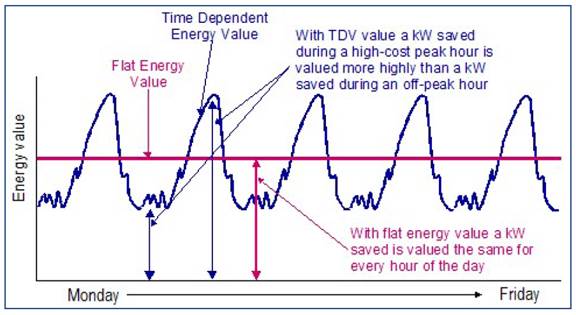
The ACM Approval Manual describes the application and approval process for submitted compliance software. The ACM Approval Manual is adopted as part of the Energy Standards rulemaking process. The Nonresidential and Multifamily ACM (NRMFACM) Reference Manual is approved by the California Energy Commission (Energy Commission) and includes explanations of the instructions that all compliance software programs must use to model the energy performance of the Proposed Design Building and the Standard Design Building. The reference manual also includes an explanation of the reference method and certification tests used by the Energy Commission to approve compliance software tools. Since the NRMFACM Reference Manual is approved by the Energy Commission (just like the residential and nonresidential compliance manuals), it can be updated from time to time to allow for corrections and enhancements during the 2022 Energy Standards cycle.
The Warren-Alquist Act requires “performance standards” that establish an energy budget for the building in terms of energy consumption per square foot of floor space. This requires a complex calculation of the estimated energy consumption of the building and the calculation is only suited for a computer. The Energy Commission has developed a public domain computer program to do these calculations known as California Building Energy Code Compliance (CBECC). For compliance purposes, The Warren-Alquist Act also authorizes the use of privately developed computer programs as alternatives to the public domain computer program. The public domain computer program and the Energy Commission approved privately developed programs are officially called alternative calculation methods. It is easiest to refer to these programs as "compliance software," which will be the term used throughout this manual.
Compliance software must simulate or model the thermal behavior of buildings including envelope surfaces, lighting, space conditioning, and service water heating systems. The calculations take into account:
•Conductive, convective, and radiative heat gain and loss through walls, roof/ceilings, doors, floors, windows, and skylights.
•Solar radiant heat gain from windows and skylights.
•Heat storage effects of different types of thermal mass.
•Building operating schedules for people, lighting, equipment, and ventilation.
•Space conditioning system operation including equipment part load performance.
•Some covered process mechanical equipment can be modeled (kitchens, laboratories, parking garages, etc.). Details of which covered process equipment is modellable in CBECC are in the NRMFACM Reference Manual.
Compliance software must be approved by the Energy Commission. Approval involves the demonstration of minimum modeling capabilities, required input and output, and adequate user documentation. The compliance software must be able to:
1. Automatically calculate the energy budget of the standard design.
2. Calculate the energy budget of the proposed design in accordance with specific fixed and restricted inputs.
3. Print the appropriate standardized compliance documents with the required information and format when a proposed building complies. Other reports that do not resemble compliance documents may be printed for buildings that do not comply.
Input and output requirements and modeling capabilities are tested by using the compliance software to calculate the energy use of certain prototype buildings under specific conditions. These results are compared with the results from the reference public domain compliance software, CBECC, which uses EnergyPlus as the simulation engine. This is explained in detail in the NRMFACM Reference Manual.
Beginning with the 2005 Energy Standards, the metric or “currency” for assessing building performance has been time dependent valued (TDV) energy. TDV energy replaced annual source energy that had been the compliance metric since the Energy Commission first adopted the Energy Standards in 1978. Starting with the 2022 code cycle, compliance will be based on both TDV and hourly source energy (HSE). For a proposed building to comply, both its TDV and HSE energy use must be less than or equal to the standard design energy budgets. More details on how proposed design energy use and the standard design energy budgets are calculated and how compliance is determined can be found in the NRMFACM Reference Manual and the CBECC or third-party compliance software user’s manuals.
As the name implies, the TDV metric values energy differently depending on the day of the year and hour of the day that a specific type of energy is used. This means that electricity saved on a hot summer afternoon will be worth more in the compliance process than the same amount of electricity saved earlier in the morning when temperatures are mild, HVAC loads are lower, and electricity grid demand for energy is lower. The value assigned to energy savings through TDV more closely reflects the long-term costs for electricity, natural gas, and propane and provides compliance credit for measures that results in load shifting from peak periods to off-peak periods.
Reference Appendix JA3 provides more information on TDV energy. A comparison of TDV energy and flat energy cost are shown below in Figure 12-1.
Figure 12-1: Time Dependent vs. Flat Energy Value

Source: California Energy Commission
HSE is an energy metric for electricity, natural gas, and propane. Put simply, HSE represents the amount of long-term depletable energy resources used to meet the energy demand of the building in each hour. HSE values are very similar to the long-term hourly utility greenhouse gas (GHG) emissions and a strong metric for encouraging building decarbonization.
Because HSE is based on depletable energy use, when renewable resources are used to generate energy, the source energy value decreases for that hour. In hours where renewable resources are scarce, source energy values increase. This means that energy savings during the night, when solar generation is low, is more valuable in HSE than savings during the morning when solar generation is greater.